Menu
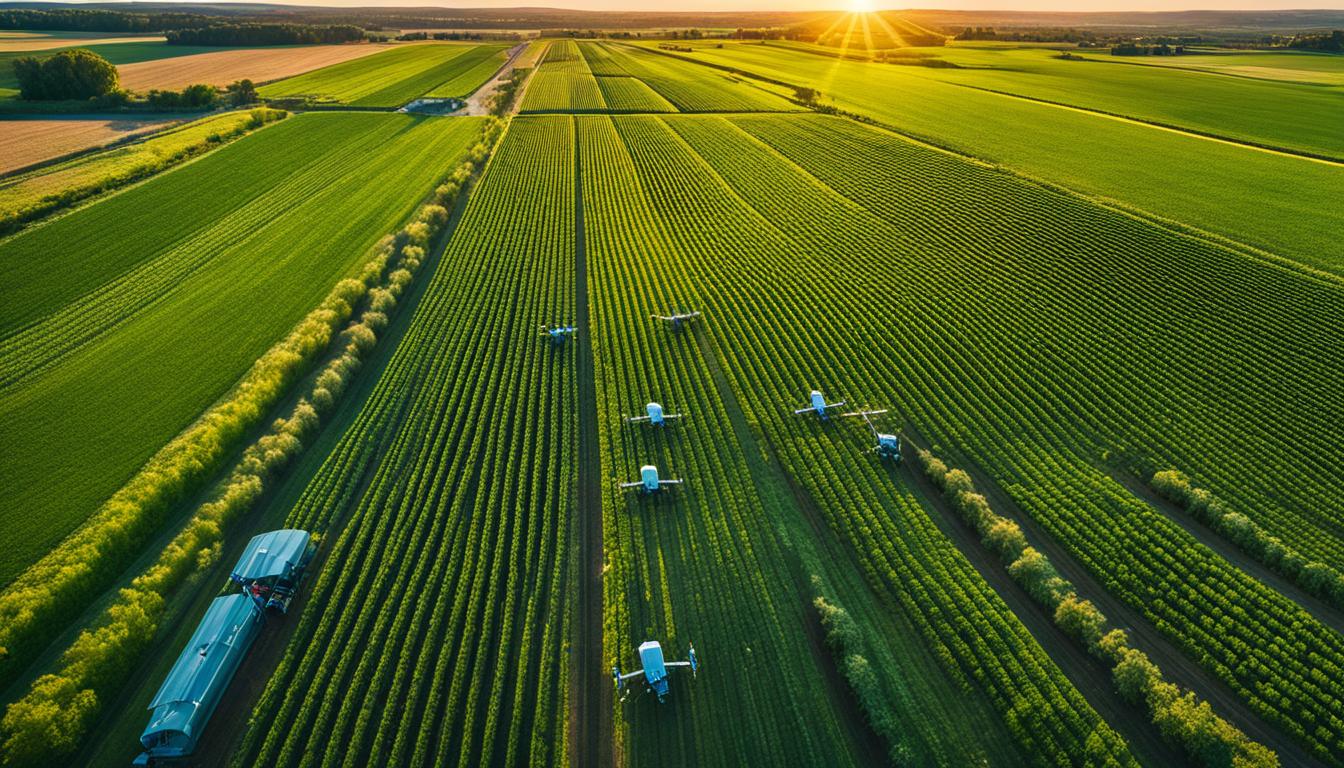
By 2050, our world will have nearly 10 billion people. This will push farming to its limit. We must find new ways to grow more without using more land. Luckily, new tech and smart methods offer hope for the future of farming.
The use of AI in farming marks a big step forward. It allows for smart solutions that boost how much we grow while taking care of the land. MarketsandMarkets says AI in farming will grow from $1.7 billion in 2023 to $4.7 billion by 2028. This shows the big change towards more high-tech farms.
Intellias, an expert in this field for over two decades, shares how AI is changing farming. Our experience shows that adding AI to farms makes things better in many ways. It leads to smarter choices, more work done, saving money, all through automatic working. This lets farmers move towards stronger and more profitable ways of farming.
By 2050, the world will have around 10 billion people. This means agriculture must find ways to produce more food. Now, we see why AI in agriculture is so important. It helps farmers work better while caring for the planet.
More people means more food is needed. But, there’s only so much land. And not enough people to work the fields. Climate change is also making things harder. This is where AI steps in to make farming more efficient.
This technology is set to become even more crucial. By 2028, it could help the market grow to USD 4.7 billion. AI can predict what will be needed in the market. It also knows the best times for planting and harvesting.
Climate change is a big threat to farming. It brings strange weather and more pests. But AI offers hope. It can cut down on harmful chemicals. And it can help farmers earn more, all while being kind to the Earth.
Thanks to AI, farmers can use less chemicals. They can also improve the quality of their harvests. This not only keeps our food system safe but also helps our planet. Sustainability is the key here.
| Challenge | AI Solution | Impact |
|---|---|---|
| Global Population Pressure | Predictive Analytics | Optimised Sowing and Harvesting Times |
| Climate Change | Automated Machinery | Reduced Herbicide Usage |
| Environmental Concerns | Data-Driven Decisions | Improved Sustainability |
Integrating AI into agriculture brings many benefits. It helps farmers make better choices and run things more efficiently. These improvements are changing the farming world for the better.
AI helps farmers make decisions backed by data. By using farm automation systems and digital farm tools, they get a clear picture of their work. This can make planting and harvesting more efficient, leading to better crops and the smarter use of resources. For example, AI can spot apple black rot with more than 90% accuracy. This shows how AI can help make sharp farming choices.
Another big plus of AI is making farming more efficient. Smart agriculture means using resources wisely which cuts down on waste and costs for manual work. With AI and IoT sensors, farmers can follow the health of their crops in real-time. This helps them only use as much water or pesticides as needed, saving resources. AI drones are also helping by spraying pesticides only where they’re needed, which is good for the planet.
| AI Applications | Advantages |
|---|---|
| AI-Driven Irrigation | Adjusts water usage based on real-time data, reducing waste |
| Predictive Analytics | Assists in market demand analysis, price forecasts, and enhancing productivity |
| Automated Machinery | Decreases manual labour, increases operational efficiency |
| AI-Powered Drones | Precise pesticide application and field monitoring |
Altogether, using AI in farming boosts productivity and limits negative effects. This way, farmers can efficiently feed the world’s growing population.
The use of AI in farming is a big step forward for agriculture. It allows farmers to work smarter, using insights from a lot of data. This helps them grow crops more efficiently and sustainably. As the world’s population grows, reaching 10 billion by 2050, we need these technologies to feed everyone.

AI’s big advantage in farming is how it analyses a huge amount of data. This leads to smart soil management and crop-growing techniques. It means better crop yields using fewer resources. A McKinsey study suggests that AI in farming could boost the agriculture sector’s income by $500 billion to $1.5 trillion a year by 2030.
AI shines in managing resources effectively. VRT, a key technology in precision farming, helps farmers distribute things like fertilizers and water based on what each part of the field needs. This cuts waste and helps the environment. The FAO says that using technologies like GPS and IoT can lower costs by 10-20% and increase crop yields by 10-15%.
By analysing a lot of data, AI can predict what the market will need and the best times to plant and harvest. This makes farming more resilient and profitable, supporting sustainable agriculture. This is crucial as the world faces growing demands for food.
The world’s population is growing fast and could reach 10 billion people by 2050. This increased demand calls for new agricultural methods. AI tools for farming help meet these needs by providing efficient solutions. From advanced software to automated farming, these tools are changing the face of farming.
Farm management software offers a complete look at farm activities. It helps in making better decisions and managing operations well. These systems use data from IoT sensors and AI to give detailed crop insights. This helps in using resources wisely and increasing farm output.
Automated reporting systems are crucial in precision agriculture. They sift through a lot of farm data to create useful reports. Farmers can then make smart choices to boost crop yields, improve quality, and earn more money. Moreover, these tools can find problems like irrigation leaks and soil issues. This helps in saving money and making farming more sustainable.
The world’s farm work is changing fast because of our growing population. By 2050, we think there will be around 10 billion people. Automation is helping agriculture a lot. New technology like AI is making farming easier and more efficient. For example, we now have driverless tractors. This tech is changing how farms operate. It’s making them faster and better at what they do.
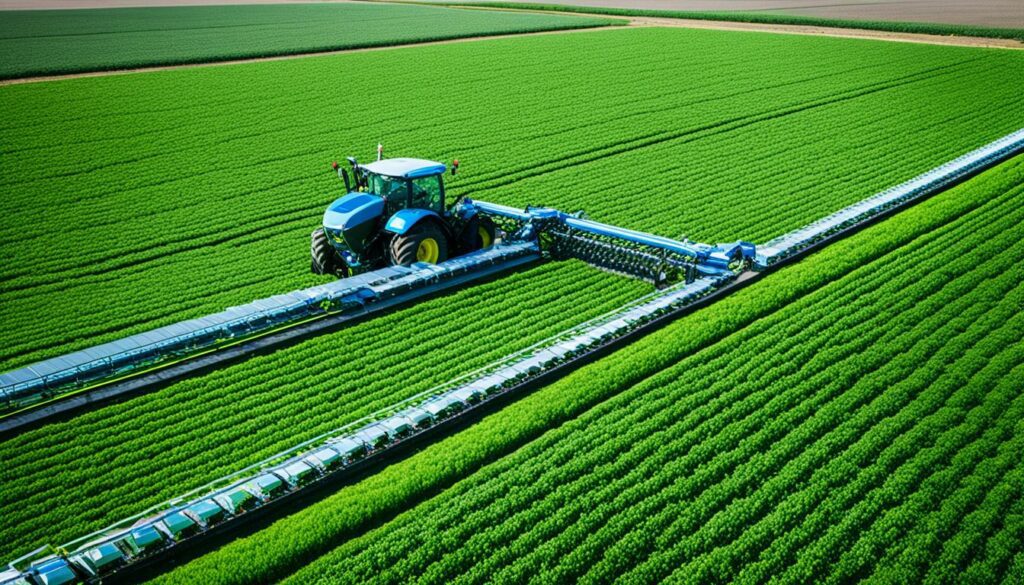
Driverless tractors are a big leap forward in farming. These machines work on their own, cutting the need for as much human help. They lower the chance of mistakes, meaning more crops can be grown. This new AI tech ensures farms are smarter. It uses resources better and cuts down on waste.
Experts say the AI in farming market will grow a lot by 2028. It could reach USD 4.7 billion. This shows that there’s a big want for tech that makes farming smart and effective. AI is already helping a lot. It’s improving how farmers manage crops and soil. Plus, drones are helping by using pesticides very accurately. Moving towards automation is changing farming for a better, greener future.
Artificial intelligence is making big progress in farming. It offers solutions that boost productivity and efficiency. With the world’s population expected to hit 10 billion by 2050, the need to produce more food is growing. The AI in agriculture market is set to jump from USD 1.7 billion in 2023 to USD 4.7 billion by 2028, showing its key role in farming now.
Predictive analytics is a game-changer in farming. It lets farmers make smarter, data-backed decisions. AI tools quickly sift through huge data sets. This leads to better crop management. They advise when to water, fertilise, and tackle pests, making sure resources are well used and crops flourish. AI also analyses weather reports, satellite shots, and farm data. This gives farmers clear, practical suggestions for better planning and results.
AI is also a star in fighting pests intelligently. Systems with AI and machine learning catch crop threats early on. They’re fed data by IoT sensors and cameras. This means spotting pests fast and advising on exact ways to stop them. It cuts down on using too much general pesticide. This smart approach saves money and is better for the planet. It helps some farmers cut their chemical use by up to 90%, supporting eco-friendly farming.
So, AI’s role in farming, especially in predictive analytics and pest control, is changing agriculture. It leads to more sustainable farming, smarter use of resources, and a food system ready for a larger, more demanding global population.
Smart irrigation systems are changing agriculture today. They combine real-time soil moisture checks with weather predictions, making farming more efficient. Thanks to IoT, these systems provide the right amount of water for crops. This saves water and supports farming that’s good for the planet.
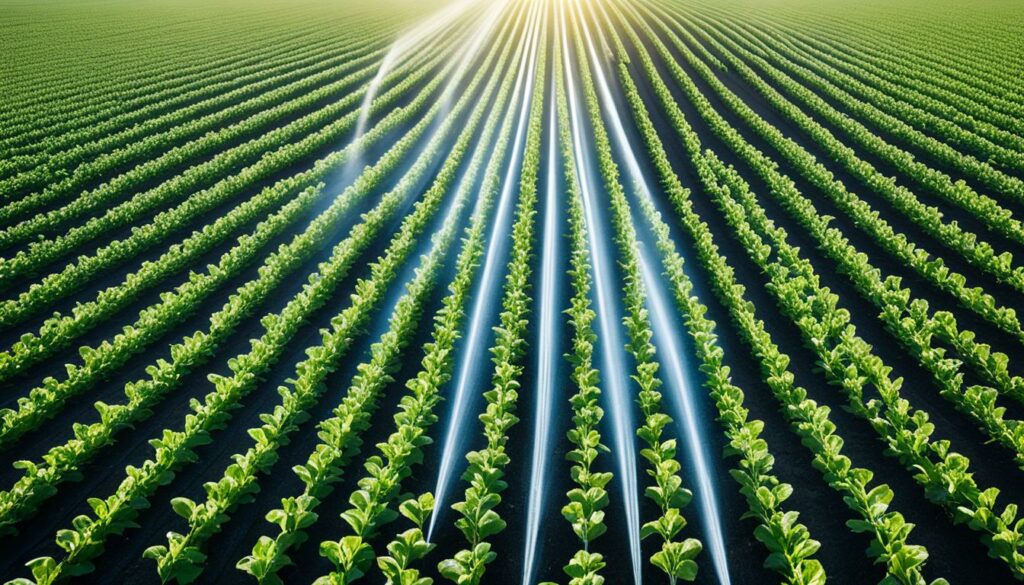
At the heart of smart irrigation systems is real-time soil moisture monitoring. This tech uses IoT to keep tabs on soil moisture without pause. By watering based on actual moisture, these systems save a lot of water. They can cut water use by up to 25%, which is huge for the environment.
These systems also let farmers watch and control water use from a distance. They can tweak the watering plan from anywhere. This means water and energy are used more effectively, helping the planet.
Weather data is a key part of smart irrigation systems too. They use weather forecasts to predict rain and adjust water usage. This feature helps avoid over or under-watering, which can hurt crops.
By using weather info with soil moisture data, these systems give crops the perfect amount of water. This leads to bigger crop yields using fewer resources. They can save up to 50% of water, showing AI’s big impact on farming.
The mix of soil moisture checks and weather predictions is making farming precise. With these systems, farmers get more control, work more efficiently, and protect the environment.
By 2050, the world aims to feed a population of 9.8 billion. This pushes agriculture to grow more food and maximise yields. The advancement of AI in crop monitoring and early disease detection is crucial. These technologies use computer vision in agriculture to check plant health. They spot diseases early, helping to save crops.
Computer vision in agriculture ensures accurate, continuous crop watch. It uses complex AI to analyse images from drones and other sources. This tech spots health issues, nutrient problems, and diseases. The fast updates help farmers make quick, smart choices. This reduces crop loss and raises productivity.
Crop management AI is great for spotting diseases early. Traditional ways are slow and may miss things. But, AI can keep track of lots of data. It identifies issues quickly, saving time and decreasing loss.
AI not only watches for diseases but also predicts outbreaks. It looks at past data and current conditions to forecast risks. This lets farmers act ahead of time to stop diseases. Such steps make crops stronger, use resources better, and support sustainable farming.
| Advantages of AI in Crop Monitoring | Impact on Agriculture |
|---|---|
| Real-time plant health monitoring | Enables immediate corrective actions, reducing crop loss. |
| Accurate disease detection | Increases overall crop quality and yield. |
| Predictive analytics | Allows for proactive disease management and risk mitigation. |
| Optimised resource allocation | Enhances efficiency and sustainability in farming practices. |
In summary, AI revolutionises farming through better crop watch and disease watch. It equips farmers to raise productivity, keep crops healthy, and farm smarter for the planet.
AI is changing how we manage livestock, making farming more efficient and better for the animals. It ushers in what’s known as precision livestock farming. This means looking after the animals well and making sure they are very productive.
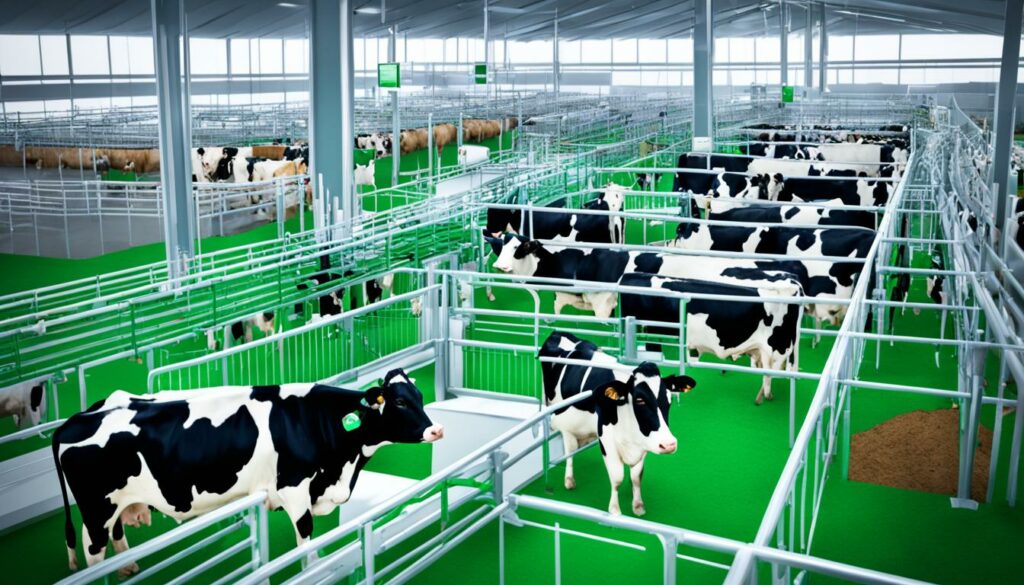
AI in farming is a big step forward. It allows us to keep an eye on the animals’ health using smart analysis. This helps spot health issues early, preventing sickness and keeping the animals safe. CattleEye, for instance, uses AI to watch over cattle, giving farmers helpful tips to care for them better.
AI health check-ups for livestock bring many advantages. They use clever technology like computer vision and special devices to watch how the animals move, eat, and their health. For instance, mooON, a wearable tech, suggests ways to improve milk production and quality, which is a big deal for dairy farmers.
AI also helps monitor animals right from when they are born. This gives farmers more knowledge, helping them make smarter choices. AI even manages some parts of the weighing process, making sure the animals are well taken care of. And it can check the environment for things like extreme heat to keep the animals healthy and happy.
| AI Innovations | Impact on Livestock Management |
|---|---|
| Computer Vision | Automatic identification and health assessment of livestock |
| Wearable Technology | Enhanced milk quality and productivity recommendations |
| IoT Monitoring | Continuous tracking of feeding and drinking habits for insights |
| AI-driven Analytics | Early detection of anomalies and health issues |
The use of AI in farming shows how much can change in agriculture. With tools like AI recognising pain in animals, or cutting down accidents, AI makes a big difference. It’s proven to be very effective.
There’s also AI that understands what chickens’ sounds mean, to help them when they’re in trouble. Plus, there are gadgets like Beehome for bees and AI feeding systems for fish, which cut waste. All these make looking after animals better, making the whole farm industry more efficient and caring.
Vertical farming is changing agriculture with its compact growing systems. It uses AI to improve farming. This boosts both productivity and the eco-friendliness of the process.
Vertical farming solutions stand out by making the most of small spaces. They use automated rack systems. This means crops can be grown on top of each other. It leads to more produce from the same space compared to traditional farms.
AI controls factors like temperature and light in indoor farms. This ensures the best conditions for plants all the time. For example, the racks move the plants to get the best light and nutrients.
Also, AI helps with daily farm tasks, making everything more efficient. With systems like those from AGEYE, farmers can oversee their farms better. They can see everything from how plants are doing to operating the growing area.
| Feature | Benefit |
|---|---|
| Automated Racking Systems | Maximise space use and grow more crops. |
| AI-Powered Environment Control | Make perfect conditions for plants all year. |
| Integration of Robotics | Do tasks better and with less work from people. |
By using AI with vertical farming, we get better, greener farming. It meets the food needs of more and more people.
Modern agriculture is changing fast. The Internet of Things (IoT) is making a big difference. It allows farmers to work more efficiently, boost productivity, and care for the environment better.
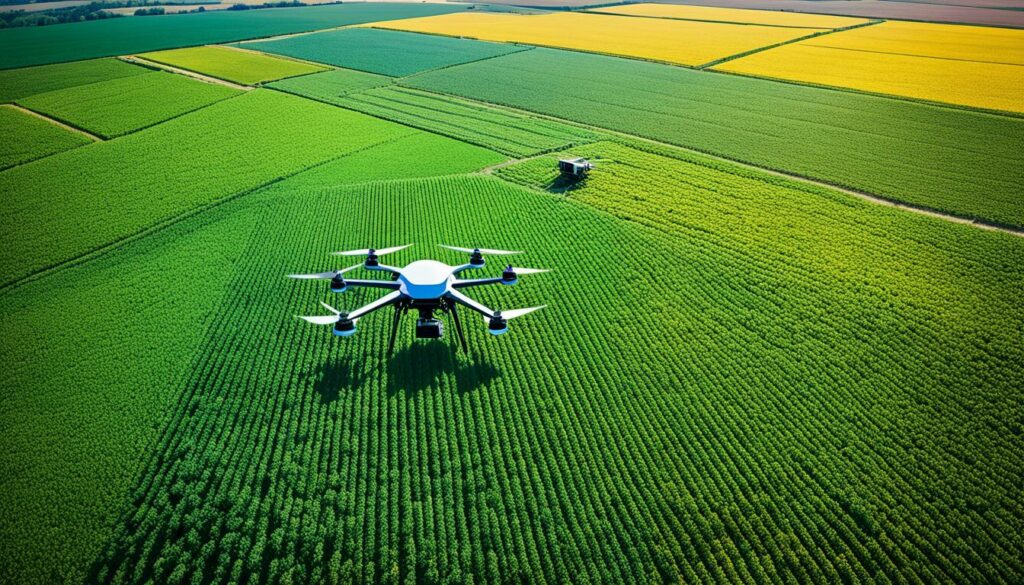
In agriculture, IoT sensors are key. They collect data in real time. Microsoft’s FarmBeats Azure, for example, tracks info on soil moisture, weather, and crop health. This data helps farmers make smarter choices and run their farms better.
Special water sensors, like those from Precision King, are also very helpful. They check on water levels to improve how rice is grown. This means using less water and getting more rice.
Smart greenhouses are a big step in farming technology. They use IoT to control the climate for plants. This means plants can grow well, no matter the weather outside.
iFarming by IBM is a great example. It cut water use by 40% and boosted productivity by 30%. Smart greenhouses also save money, like when Kagome tracks their tomato deliveries.
With a projected world population of 9.7 billion by 2050, we need to grow more food. IoT will help by monitoring crops, using resources better, and analysing data. It shows the big role IoT will play in the future of farming.
| Statistic | Impact |
|---|---|
| Projected global population by 2050 | 9.7 billion |
| Increase in food production needed | Up to 70% |
| Connected agriculture market value in 2019 | $3.35 billion |
| Projected connected agriculture market value by 2025 | $6.99 billion |
| Reduction in water use with IBM iFarming technology | 40% |
| Success rate in monitoring tomato deliveries by Kagome | Saved five times the initial investment |
The world’s population is set to hit 10 billion by 2050. To meet food demands, agriculture needs to change. Machine learning in agriculture is key to this shift. It mixes smart algorithms with age-old farming techniques. This mix boosts efficiency and manages resources better thanks to agriculture automation technology.
Predictive maintenance is a major use of machine learning in farms. It predicts equipment failures before they happen. This cuts down on repair time and lengthens machinery life. It’s crucial for driverless tractors and complex irrigation systems, which agriculture automation technology depends on.
This type of maintenance also uses AI to spot trouble early. It’s vital for an industry with small profits and big risks. The AI in agriculture market is growing fast, reaching USD 1.7 billion in 2023. It’s expected to hit USD 4.7 billion by 2028. This growth shows the world is turning to advanced AI for better farming. For example, it helps find leaky irrigation systems early and checks soil health with computer vision.
In short, machine learning in agriculture is changing farm maintenance. It brings reliability and efficiency to a crucial area. As the need for food rises, these technologies are becoming more important. They help use resources well and promote eco-friendly farming.
AI is changing the game in supply chain management for agriculture. It makes distribution more efficient and tracks inventory live. By using AI, we combine machine learning with big data analysis. This combo makes demand predictions sharper. It ensures steady supply and cuts down waste.
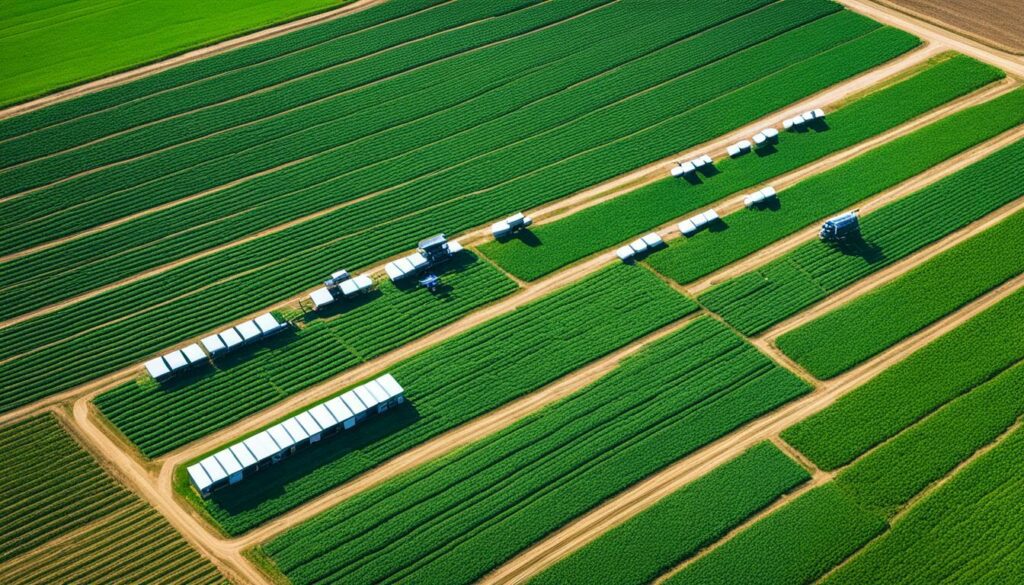
AI has a big impact from farm to market. It uses predictive algorithms to look at transport routes, weather, and previous data. This analysis boosts both efficiency and productivity. It makes moving goods better and lifts the performance of distribution systems.
AIs help plan delivery routes, making handing out agricultural products smoother. AI systems let farmers and sellers deliver goods faster. They also cut down on waste, making sure products get to markets in great shape. This makes the whole distribution process more effective.
Using AI drones and satellites lets us watch over crops all the time. This tech helps schedule the best time for harvesting and storage. It means we use our resources well, lower costs, and make the supply chain better overall.
Keeping an eye on stock all the time is a huge deal for farming. Thanks to AI, we get very accurate stock checks. This stops us from having too much or too little stock. It gives farmers and sellers the insight they need to match stock with what the market needs. This makes our supply chains quicker to respond.
| Aspect | Benefit |
|---|---|
| Demand Forecasting | AI gives precise predictions. This cuts waste and makes sure goods are available. |
| Distribution Networks | Adjusting routes in real-time gets things delivered on time and saves money. |
| Inventory Tracking | Keeps watch to stop running out of stock. This cuts down on having too much stock. |
In wrapping up, using AI in supply chain management improves agriculture. It means better products, happier customers, and lower costs. As farming keeps changing, AI remains key in building better distribution and supply chains.
Sustainable farming with AI is changing farming for the better. It’s improving both how much we grow and how we look after the planet. As the world’s population grows to 10 billion by 2050, the need for better farming is urgent. AI helps with smart fertilisation and using less water, key for farming’s future.
AI in farming means nutrients for crops are now spot on. With smart machines and drones that think, the perfect dose of fertiliser is given to each spot in the field. This saves money, cuts pollution, and is great for the Earth. AI also geekily predicts what plants need by checking soil, old harvests, and current growth, making farms super efficient.
AI is also a superhero for saving water in farming. It uses signals from the dirt, weather forecasts, and what plants want to drink to decide on watering. This stop the use of too much water and saves the soil. It also makes sure crops grow well. Smart farming with AI is a big win for saving water and farming wisely.
The AI market in farming is growing fast, from USD 1.7 billion in 2023 to a projected USD 4.7 billion by 2028. This means more high-tech and green ways to farm are on the way.
AI in agriculture brings great promise. But, there are big hurdles to overcome. These challenges are key in fully realising AI’s benefits in farming.
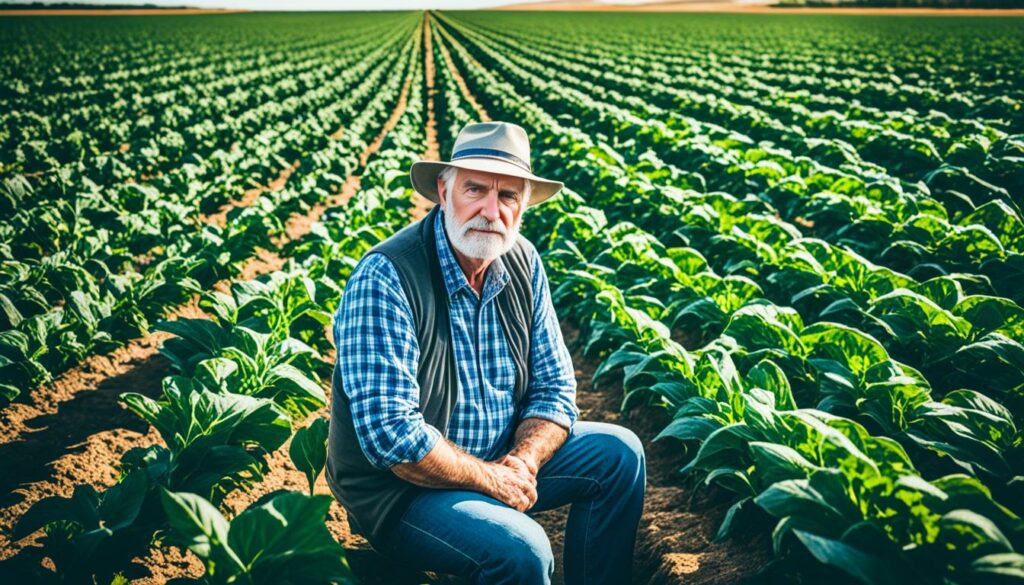
Challenges of AI in agriculture are often tied to farming’s setup. Small farmers and those in poorer countries lack high-tech tools. Buying AI tech can be very expensive, keeping many from using it. Also, there is not always enough help available to use and fix these new tools.
The world’s rules on AI use are not the same everywhere. This makes it hard for everyone to jump on board. The gap between rich and poor countries in technology use makes matters worse. It makes getting AI support even harder for those who need it most.
Still, the setup of farms can stop AI from being really useful. This makes some farmers unsure about using AI tools. By fixing these basic issues, we can help more farmers use new technology in their work.
The way we do farming is changing because of AI. These AI trends aim for farming to be more efficient and kind to the planet. It’s crucial, as we expect the world’s population to hit 10 billion by 2050. This growth means we must change how we farm to keep people fed and the Earth healthy.
AI’s role in helping us cope with climate change is very important. It’s already helping us grow crops that can survive droughts and using water wisely. Thanks to AI and smart sensors, farms can watch over themselves. They check the moisture in the soil and the weather, and make smart choices. This way, we save water, grow better crops, and make more money.
These steps are crucial in fighting climate change’s effects. They make farms stronger and better for the environment.
Blockchain is about to change how food gets from the farm to your plate. It makes sure food is safe, of high quality, and meets standards. By looking at how inventory and food move, blockchain and AI make a faster, trustworthy system. This system lets farmers and shoppers know where their food comes from. It builds trust. And it matches the trend towards wanting food that’s good for us and the planet.
Standing at the edge of a new farming era, AI is reshaping agriculture. It promises to tackle the challenge of feeding a growing global population. By 2050, the world will have 9.8 billion people to feed.
AI brings tools like predictive analytics, automation, and disease detection. These technologies boost productivity and sustainability. They pave the way for a more efficient and intelligent farming future.
Precision farming is a big step in this tech evolution. It allocates resources like water and pesticides smarter. This not only increases crop yields but also reduces harm to the environment.
AI helps overcome challenges like limited land and scarce resources. It makes farming decisions based on data. This leads to more effective, less wasteful farming. It encourages a sustainable approach.
AI is also key in dealing with climate change and making food supply chains better. Although using AI in farming at first seems costly and poses some challenges, its benefits in the long run are major. The future of agriculture is about keeping up with innovation. It aims for a strong, sustainable, and productive farming world for all generations.
AI-powered farm management uses smart tech to make farm work better. It looks into growing crops, using resources well, and making smart decisions.
AI boosts crop growth and farm work with clever insights. This makes sure there’s enough food for a growing world.
AI helps farms use less and work better. It means less waste and fewer bad effects on nature from farming.
AI gives farmers smart tips using real-time data. This helps with planting, harvesting, water use, and stopping pests.
AI cuts down on manual jobs, uses resources better, and stops waste. This makes farms work cheaper and better.
AI is key in precision farming. It helps manage data well for smart and efficient use of resources, boosting crop growth and doing it sustainably.
These are special software and systems for farms. They show everything about the farm, make managing it easier, and help with smart choices.
Automatic reports analyse farm data to give useful advice. This helps farmers grow more food and make more money by working smarter.
These include tractors that drive themselves, machines that harvest without help, and more. They reduce hard work and make farming look after itself better.
Predictive analytics use AI to guess farm jobs and results, like how much crop will grow. This makes farming decisions better and farm work more efficient.
Smart pest control uses AI to watch and guess what pests will do. This helps farmers stop problems before they hurt their plants.
These systems watch how wet the soil is and the weather. They use this to water plants just right. This saves water and farms the green way.
AI watches plants closely and finds diseases fast. This lets farmers care for their crops better, lowering losses and raising harvests.
AI helps keep an eye on the animals, spotting when they’re not well or acting odd. This can improve how the animals are looked after and the farm works.
In high-up farms, AI helps make small spaces grow a lot of food all year. It uses tech to control the farming environment without hurting the planet.
They keep farms in check all the time. This helps the farm run well and makes the plants grow just right.
Predictive maintenance guesses when farm machines might break, stopping them from going wrong. This keeps the farm going without big stops.
AI makes shipping and keeping track of stock better and faster. This means the food arrives fresher, everyone’s happy, and it’s not too dear.
AI helps farm without wasting water and fertilizer. This cuts waste and makes farming kinder to nature.
Setting AI up can be hard due to not enough tech and tough rules. But, it’s part of making farms better.
The future sees AI fight climate issues in farming by making tougher crops and using water well. Also, blockchain will make sure food is tracked safe from farm to plate.